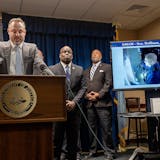By the letter of the law, it's illegal to drive faster than the posted speed limit, but many drivers push it by going a few miles per hour over the limit or even much faster.
Drive reader Nancy was recently on a Twin Cities freeway and said she was going about 5% over the posted speed limit. Yet most drivers, she said, were going even faster.
"I find that I no longer really know what speed I should drive," Nancy wrote in an e-mail. "To me the question is what should a safety-conscious driver do to make the roads the safest? Drive exactly the speed limit, slightly over or slightly under?"
The Drive took her questions to Pete Hosmer, driving instructor at A+ Driving School in White Bear Lake.
"We teach that the safest speed on the road is the posted speed limit," Hosmer said. "On local freeways, that is usually 60 mph."
But it's also important to note which lane a driver is in, he said. On roads, highways and freeways with more than one travel lane going in the same direction, the right lane is the "through lane" and should be used most of the time.
The left lane, Hosmer said, is a passing lane — not a fast lane as the speed limit is still in effect — and should only be used when passing a slower car or when making a turn. Of course, there are times when drivers need to use the left lane, such as during rush hour when congestion necessitates its use.
"I do realize that people drive faster than the speed limit all the time, but based on drivers reaction times, following distances and speeds, driving the speed limit and staying in the appropriate lane is key," Hosmer said.
![A black bear stopped after crossing Big Bay Road on Madeline Island, the largest of the Apostle Islands in Wisconsin, on Monday, May 31, 2021. ]](https://arc.stimg.co/startribunemedia/PWNYGIY3WTSWDBOGOYD775DPP4.jpg?&w=80&ar=1:1&fit=crop)


